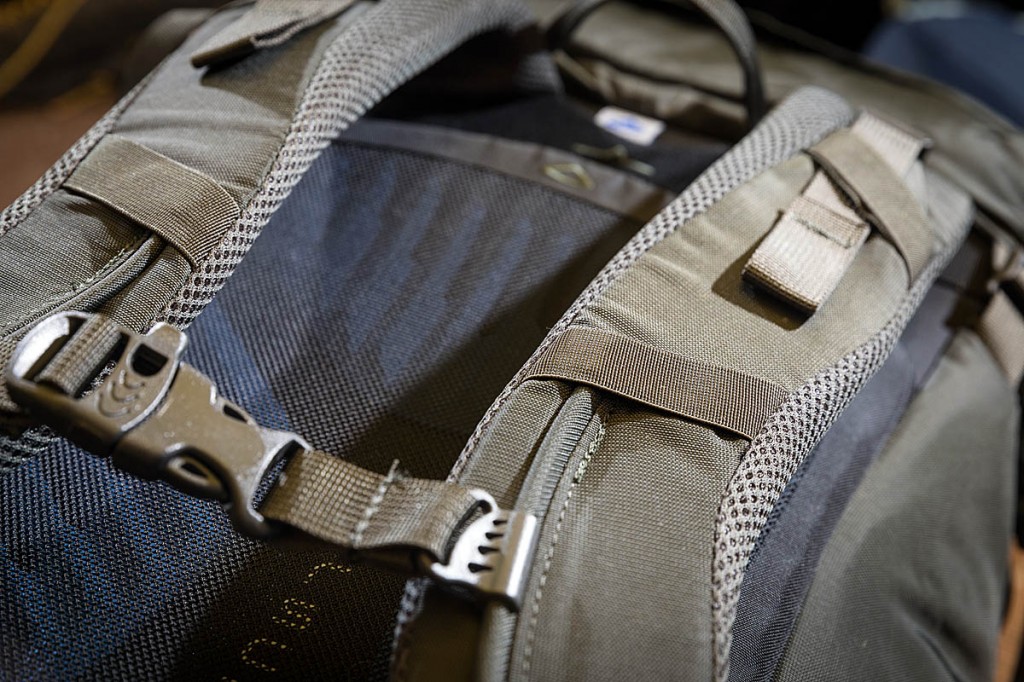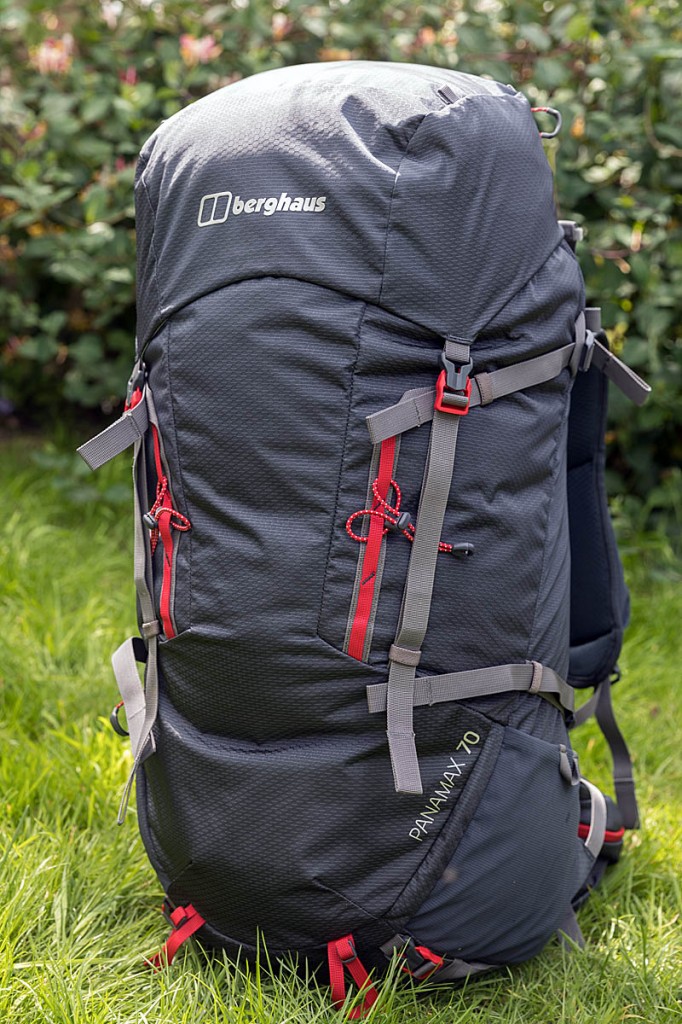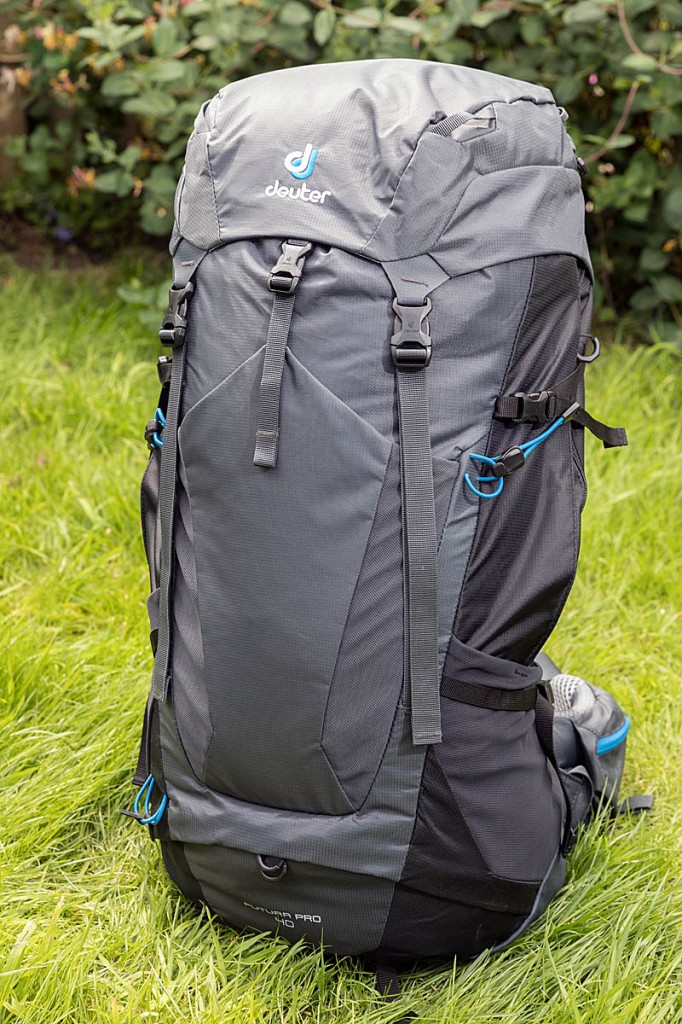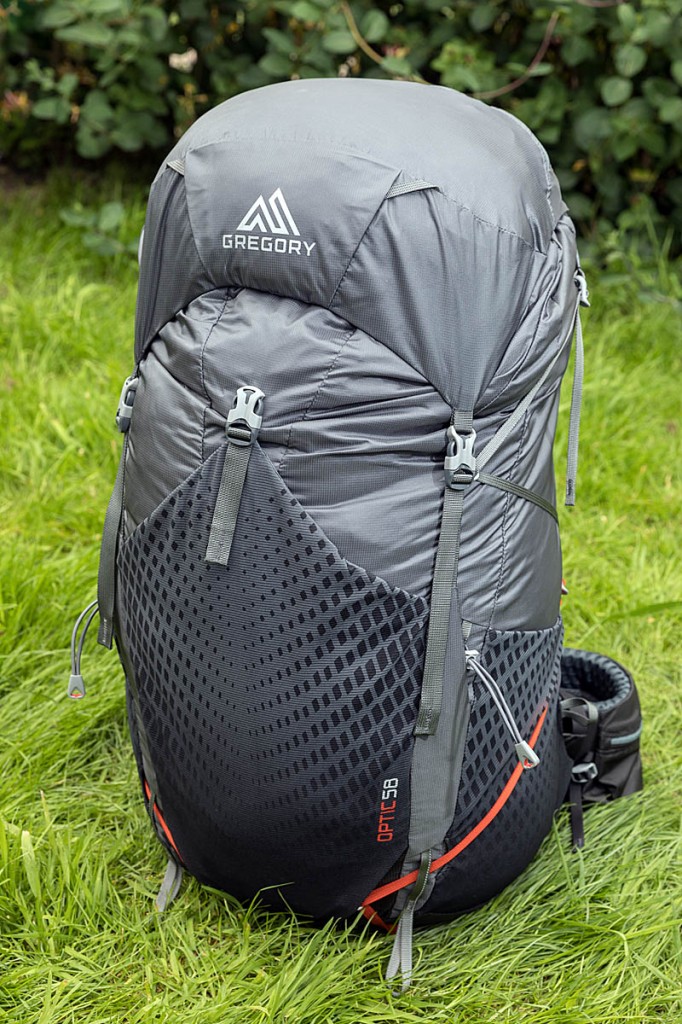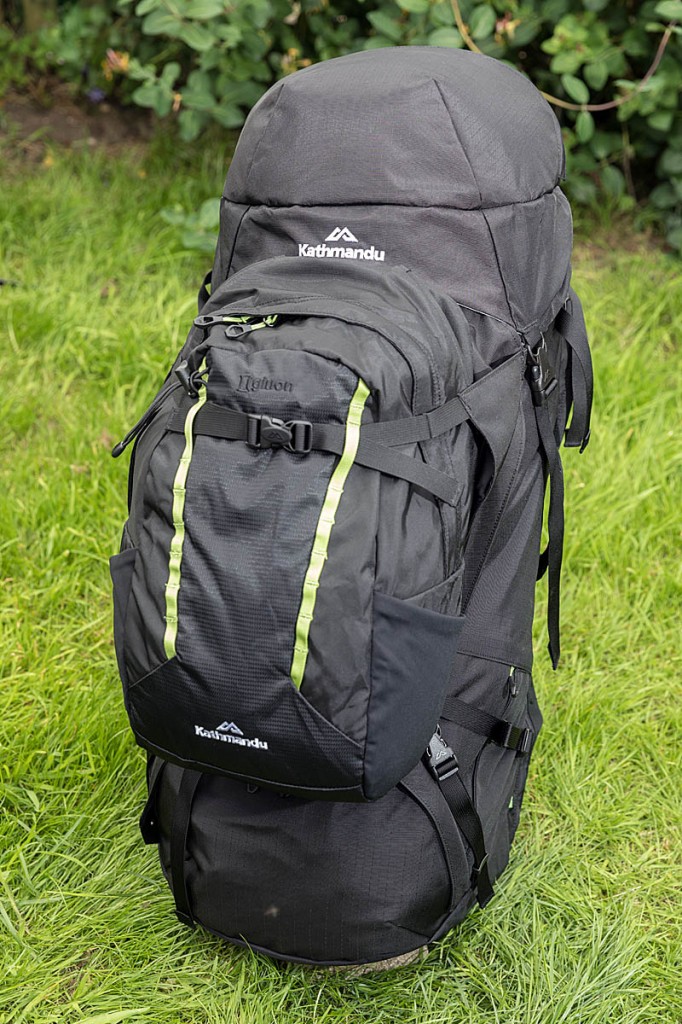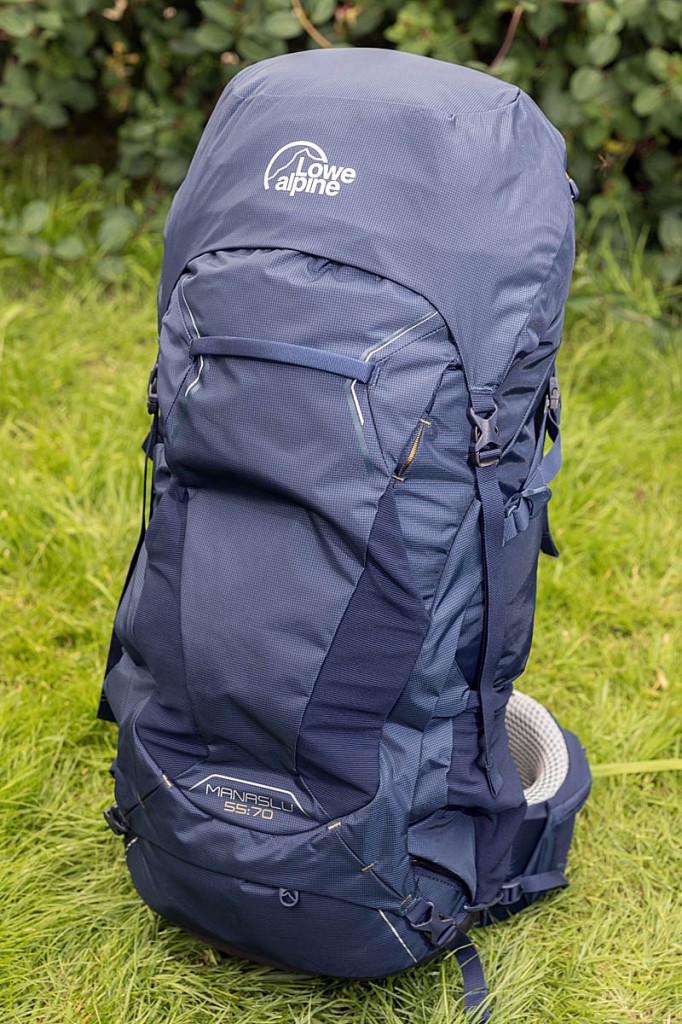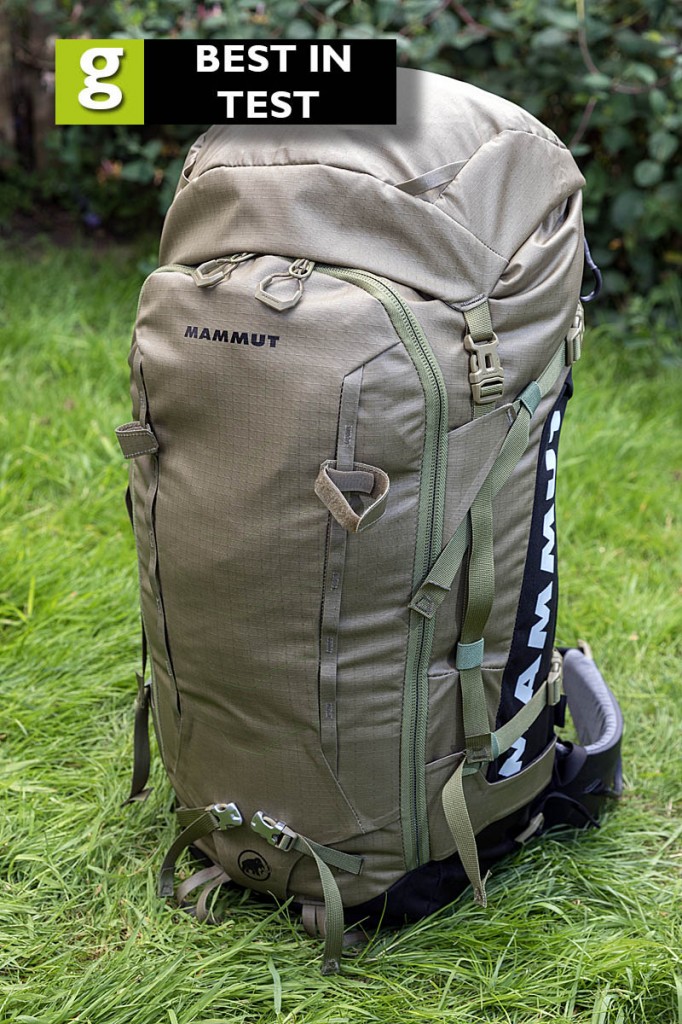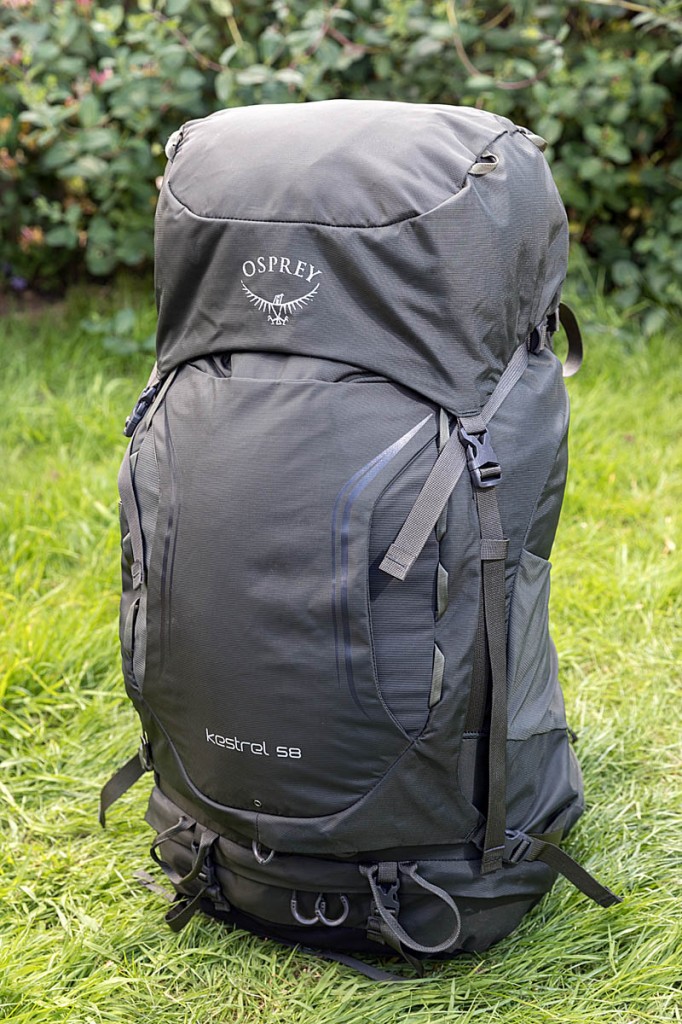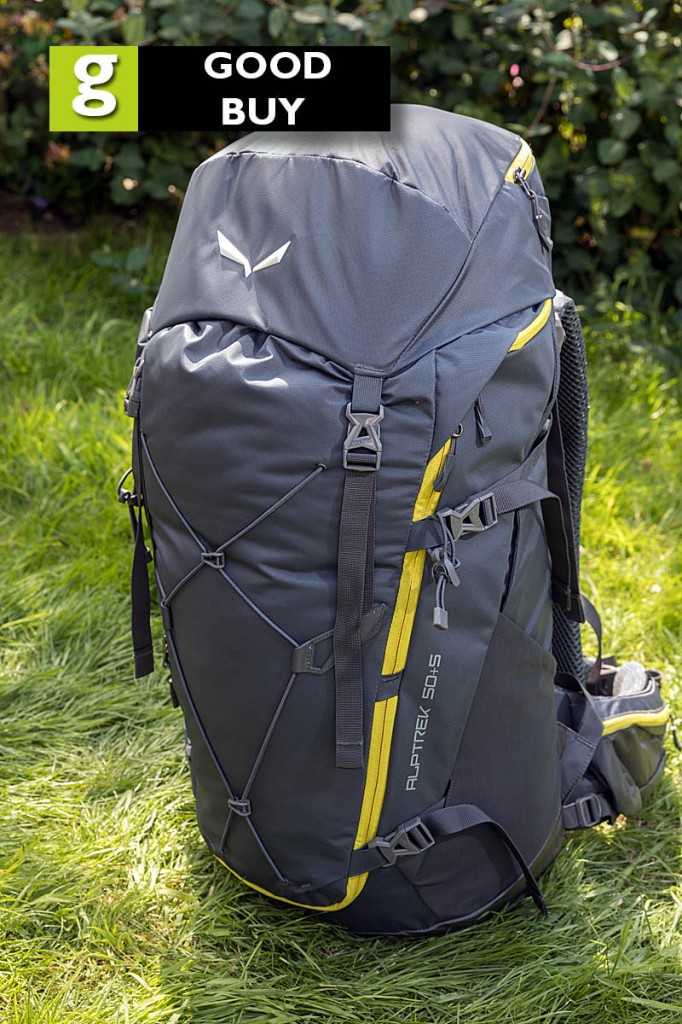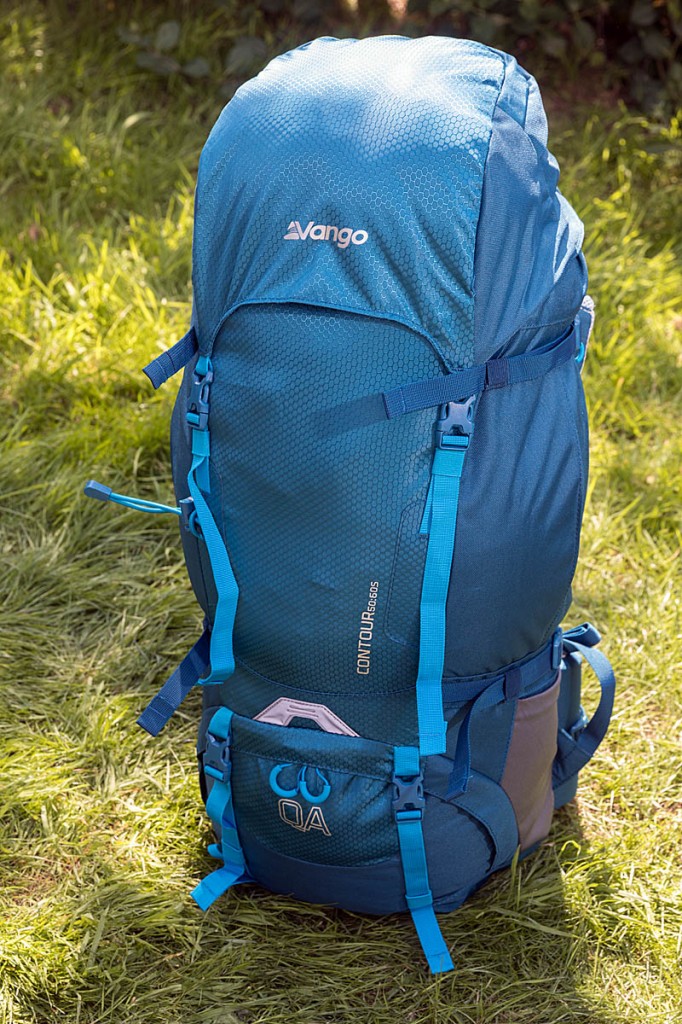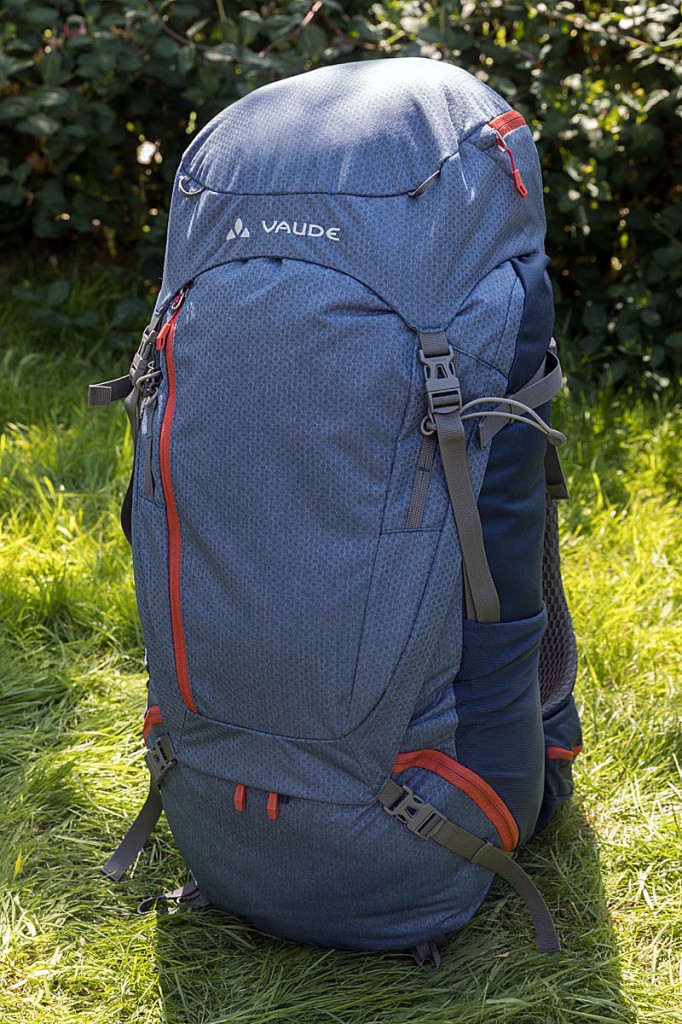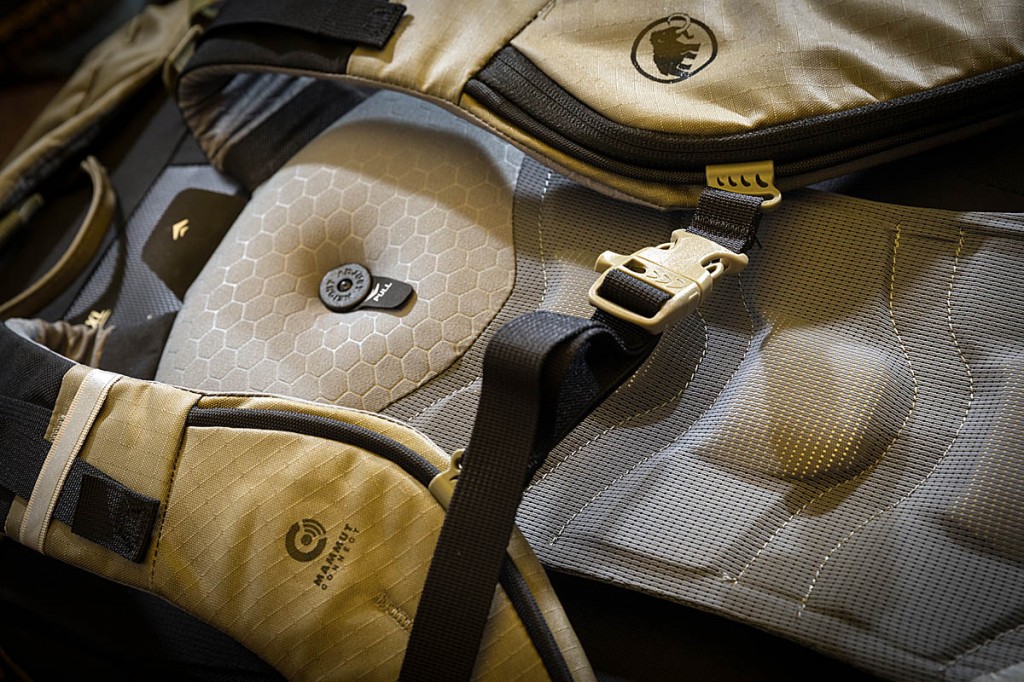If you’re heading out on a multi-day walking trip or wild camping on the hills, you’ll need a rucksack that’s big enough to take all the necessary gear.
With winter on the horizon, hillgoers will also have to carry more kit: extra clothing, crampons, ice-axe, gloves, hat, headtorches and all the other essentials to enhance safety, even on day walks.
We’ve had 10 larger packs on test over an extended period. This has included wild-camping trips in the hills over a number of days, as well as shorter walks with full kit.
Our review of the rucksacks evaluates how well they performed in accommodating the gear, how stable they felt on the back and how comfortable they were while carrying a total weight of about 14kg to 16kg, typical of a wild-camping kit.
We’ve also rated the useful features the packs have, the overall quality of the materials, design and manufacture, plus a value for money score.
The rucksacks ranged from 40 litres to 70 litres. Some have a higher capacity figure also, which is usually achieved by extending the upper gaiter and floating lid to provide more storage space when necessary. One pack is designed specifically with travelling backpackers in mind, with features reflecting that user’s needs.
One point to note: although some of the packs have a water-resistant treatment, none of them claim to be waterproof, because rain will enter through seams, so you’ll need a liner or drysacks to keep your gear dry in wet weather.
Berghaus Panamax 70
Price: £180
Weight: 2,228g
Country of manufacture: Vietnam
Colour: grey
Rated capacity: 70 litres
The Panamax is Berghaus’s big load carrier introduced this year.
A lot of thought has gone into the rucksack’s features, some of which are borrowed from innovations found on trailrunning gear.
The 70 litre pack has a chassis that uses a single longitudinal alloy strut down the back, with a composite plate, with a slight s-bend shape, giving the rucksack good stability throughout its body.
In use, the load is spread mainly in the shoulder area of the back and around the coccyx, creating a small space in the small of the back for ventilation but not large enough to move the pack away from the body and induce instability.
There is generous padding in the shoulder blade area and good padding in the wide harness straps as they come over the shoulder. The hip belt has equally generous padding in the lumbar area and in the wrap-around fins, which feel snug on the hips when carrying a load. The hip belt is articulated towards the bottom of its attachment to the main body, allowing upwards and downwards movement when crossing uneven ground.
The back length can be adjusted using two large hook-and-loop pads which, when loosened, allow the harness assembly to be slid up and down to the desired length. There are markings from XS to XL, though the back can be positioned at any point between these. For use at the XS setting, there are two alternative attachment buckles lower down the back for the top harness attachments.
The body of the Panamax uses 210 denier honeycomb-pattern nylon, which feels robust.
The main compartment has a top entry secured by a drawstring. It can also be accessed via a zip that runs down the side of the pack. Inside it is a pouch with hook-and-loop hanging strap for a hydration reservoir. Drink tube exit is central, so it can be passed down either harness strap.
There is also a good sized bottom compartment accessible by a separate zip, which will accommodate a sleeping bag and stove. The divider that separates the main and lower compartment can be unzipped if required, to create one big space – useful if, for instance, you have a long tent that won’t fit in just the upper compartment.
The lid is a floating design, with adjustable straps securing it at the back, allowing the lid to be raised if carrying more gear than can be contained in the main compartment with the closure cinched.
The main lid compartment is a good size with a zip at the rear. Inside it is a key loop. On the underside of the lid is a second zipped compartment.
The harness straps broaden out as they pass down towards the collar bone area, and below this the fabric and padding are softer. There are two small mesh pockets here, with elasticated tops, for keeping items such as a mobile phone or GPS device in.
The sternum strap is attached via a daisy-chain array, with four different positions. There are also on the harness straps two pairs of elasticated cord loops. These can be used for hooking on the detachable lid so it’s on the front of the body, with items for which you need instant access. If the lid is removed, there are a couple of extra buckles to secure the pack’s top to the lower attachment straps usually accommodating the lid buckles.
This feature is a good one for backpackers with a heavy load who don’t want to have to take off the full pack each time they need to access an item from the lid.
The hip belt also has good sized twin zipped pockets for small items. The belt can be cinched in to bring it closer to the body.
There are elasticated mesh pockets, with a handy loop for stretching out the top hem, on each side of the pack, for drinks bottles. The rucksack has twin walking pole or ice-axe attachment loops and upper retaining bungees. It also comes with a rain cover stored in pouch at the bottom of the pack, with a hook-and-loop closure.
The new Berghaus rucksack is big enough to swallow your lightweight tent and all the gear you need for a backpacking trip. It feels stable on the back and was reasonably comfortable with a total weight of just over 14kg on our tests.
The hip belt worked well but the harness straps are not as comfortable as we would like. A little more padding wouldn’t go amiss, though the straps are wide and spread the load well.
The extra little pockets on the front of the pack’s straps are useful and the ability to hang the lid on the front of your body is also a good feature which eliminates the need to take the rucksack off to get at smaller items while on the hoof.
The unusually designed buckles work well and are smooth in operation and overall the quality of the Panamax 70 is good.
Performance 25/30
Comfort 23/30
Features 18/20
Quality 7/10
Value for money 7/10
Total score: 80/100
Deuter Futura Pro 40
Country of manufacture: Vietnam
Weight: 1,672g
Price: £145
Colour: grey
Rated capacity: 40 litres
The Futura Pro 40 sits at the smaller end of the test’s capacity range, and is suitable either for backpackers with a lightweight small kit or for day walkers hitting the trail when more gear is needed to be carried during the colder months.
The main
compartment is long enough to accommodate a typical lightweight two-person tent, and there is also a separate zipped bottom compartment for sleeping bag or stove.
The back is Deuter’s Aircomfort Sensic Pro system. In a nutshell, this is a slightly curved solid plate supplemented by two sprung steel struts either side of the spine area, which then curve outwards to the shoulder area. A mesh area with extra ventilated padding at the sides then sits against the wearer’s back, enabling air to pass between the pack and the wearer to reduce perspiration. The two padded areas continue downwards and integrate with the hip belt’s fins, which are broad and well padded. There’s also a solid cushioned section at the lumbar area. The harness straps are fairly broad and also feature ventilated padding. The sternum strap is adjustable via rails on each side.
The hip belt has two small zipped pockets.
The pack’s main compartment is a good size and contains a hydration reservoir pouch and hook-and-loop suspension strap. Drink-tube exit is to the left shoulder.
The separator between main and lower compartment can be unzipped to create one larger area if required. This might be necessary if your tent is longer than the main compartment.
There’s a good sized exterior pocket on the front of the rucksack, secured by a strap and buckle, which is useful for stashing wet gear in to keep it away from other items. The main body of the pack is tough-feeling ripstop 210 denier nylon Dynajin material, with reinforcement at the base.
The Futura Pro 40 also has two external zipped side pockets, long and fairly narrow, either side of the main body, along with twin stretch mesh bottle pockets.
There are two shockcord pole loops on one side of the pack, with corresponding adjustable bungee attachment loops at the top, and there’s a separate webbing ice-axe loop and attachment bungee.
The pack has a tethered rain cover in a zipped compartment at the base and the rucksack has two pairs of compression straps.
The lid is fixed and has a good sized zipped compartment with key loop. It also has four small webbing attachment loops on the top. On the underside is a zipped pocket for smaller items. As is common with many European packs, there are also printed instructions on rescue signals.
We just about managed to fit a summer’s wild-camping kit into the pack, but in our view it’s best viewed as a larger day pack for when you need to carry extra winter gear or group equipment.
Total pack weight during testing was 12kg and the Deuter rucksack felt comfortable with no discomfort from the harness straps or hip belt, both of which helped the Futura Pro 40 hug the body well.
There was a little build-up of back perspiration despite the mesh netting, but overall the Deuter pack fell into that desirable category of a piece of kit you put on and can then forget you’re using it.
It felt stable on rockier terrain and overall worked well as a load carrier. Quality was good.
Performance 24/30
Comfort 26/30
Features 16/20
Quality 7/10
Value for money 7/10
Total score: 80/100
Gregory Optic 58
Country of manufacture: Philippines
Weight: 1,278g
Price: £200
Colour: grey
Rated capacity: 58 litres
The Optic 58 has a single large main compartment that was surprisingly roomy for its stated capacity.
We managed to fit all of our gear for wild camping into the Gregory pack, which had an overall test weight of 13.6kg.
The Optic 58 was the lightest rucksack in the test, thanks to several features including the use of 100 denier nylon with a reinforced 210 denier base. Some of the straps, notably those in the compression system, are pared down. Despite this, the main body of the pack feels robust and has a 135 denier polyester lining.
The back is Gregory’s Aerospan system, which is also aimed at keeping down weight. It has a hollow aluminium frame which supports the pack at each side and loops over the top of the shoulders. A further internal support element crosses at the mid-back level to aid stability in that area. A flexible plate runs the length of the back.
There is then an elasticated mesh net which sits against the user’s back and allows air behind to help ventilate. The top of the harness straps integrate into the upper section of this net and at the bottom there’s generous padding in the lumbar region from the rear section of the hip belt.
Both the harness straps and the hipbelt have ventilation perforations. The harness has dual density foam, which gives reasonable comfort. The hip fins have good padding and were comfortable.
There’s no back-length adjustment, but the Optic 58 comes in three sizes.
The harness has a sternum strap, continuously adjustable on rails, and a little elasticated sunglasses holder. The harness has lightweight adjustment straps at the top, to pull the pack closer in to the body.
The hipbelt has broad fins, each of which have a zipped pocket on them. The actual adjustment straps are twin webbing arrangements, with length adjustment by pulling through buckles to the centre of the belt. There are lightweight tensioning straps at the hips to cinch the belt in closer to the body.
The system supported the load well, and the pack felt stable, hugging the body well, useful on more technical terrain. It didn’t hinder movement when reaching and stepping up on steep ground.
The Gregory pack’s main compartment has a hydration reservoir pouch and hanging loop, with the drinks tube exit central, so it can be routed to either harness strap.
On the front of the rucksack is a large stretch mesh pocket, with a buckle fastener, useful for storing items such as wet clothing. There are also two large side stretch mesh drinks bottle pockets. A useful feature of both of these is that, in addition to having the conventional top entry, there’s an elasticated side entry with pull loop, which makes it easier to slot in and retrieve drink bottles without taking the pack off.
There are twin zig-zag compression straps on the side of the rucksack, the lower ones being 9mm width and the upper ones 7mm. The lower compression straps can either be passed through the drinks pockets or around the outside of them.
The Optic 58 has a pair of pole or ice-axe loops, with bungee retainers at the top of the body. The lid has a good sized zipped pocket and a separate compartment houses the rain cover. The lid is a floating design for adding extra capacity if needed, and is also removable if you want to shave a few grams off the weight. The pack’s main compartment closure cinches tight and has a small buckle-retained flap to protect the contents if you do this.
We were surprised by just how much gear the Optic 58 swallowed. The simplicity of a single large main compartment aided this. The pack is well thought-out and has design features to keep weight down without compromising performance. There’s only the top opening, so you can’t access items at the bottom of the rucksack without taking out gear at the top, but an extra opening would have added to the weight.
It supported an overall weight of 13.6kg well and felt stable and overall was comfortable. Quality was good and the Gregory pack had some nice little design touches.
It’s a good rucksack for winter days when you’re packing extra gear and clothing but will also accommodate a lightweight wild camping kit during warmer months.
Performance 24/30
Comfort 24/30
Features 18/20
Quality 7/10
Value for money 7/10
Total score: 80/100
Kathmandu Interloper Grid Tech
Country of manufacture: Vietnam
Weight: 3,466g
Price: £299.99
Colour: black
Rated capacity: 70 litres
This Kathmandu is designed with the backpacking traveller in mind and has lots of features useful to the globetrotter.
It’s very sturdy feeling with 420 denier ripstop nylon with Cordura making up its main body. This, and its many features, make for a heavy pack, nearly 3.5kg before you start putting any gear in it.
With our standard test gear load, the Interloper Grid Tech weighed 16.4kg.
The Interloper also comes with a detachable daysack, the Gluon, useful if you want to leave the main rucksack somewhere safe and head out without all of your gear for some exploring.
The Kathmandu is packed with features, mostly with travel in mind. The harness straps and hipbelt stash away into a large zipped cover to lessen the chance of the pack getting snagged on airport luggage belts. With the Gluon daysack removed, the only remaining straps outside the pack are the pairs of compression straps, which have plastic tethering loops for the excess webbing, plus the top lid straps which, curiously, don’t. This makes for a neat pack for flights or on train luggage racks. The Gluon pack is well within the cabin luggage limits for most airlines, though not Ryanair’s at the time of writing. When filled, the Gluon measures about 46cm x 27cm x 20cm.
When not in use, the harness cover folds up and goes in a bottom compartment with hook-and-loop fastening.
The main pack has two grab handles on its flanks, in addition to the conventional haul loop at the top of the back.
The harness back length is adjustable using a Kathmandu’s C3 system. This has two outer rails on which the upper part of the harness slides, with a centre rail with a pawl that engages on teeth as you slide it downwards, but prevents the assembly sliding back up under gravity. A top adjustable webbing strap holds the back in place, preventing it sliding down once you have desired length. The pawl can be disengaged by lifting a small, spring-loaded lever to allow the harness to be slid up.
The ripstop fabric of the main body of the pack is very sturdy feeling, which should stand up to the rigours of world travel. The main compartment is big and, with our sleeping bag in the separate lower zipped compartment, easily accommodated our wild camping kit. The main area can be accessed via a top opening with an extended gaiter that has both an outer drawcord closure and a plastic buckle, with padlock eyelet.
The main compartment can also be accessed from a zipped opening on the front of the pack, useful for finding items at the bottom of the rucksack without removing all the other gear on top of it. Inside the main area is a sleeve for a hydration reservoir, with a drinking tube exit to the left harness strap. Within the main compartment is a large zipped pocket. There’s also a large detachable net laundry bag, held in place by toggles, useful for keeping your dirty clothing separate from unused items.
The lower zipped compartment also has a padlock eyelet and inside the separator can be opened up via a drawstring to create one large area with the main compartment.
The lid is floating, so can be adjusted upwards to give a little extra capacity if needed. It has a large-ish zipped pocket.
The Kathmandu rucksack has twin side zipped pockets, made from the same fabric as the main body rather than the more common mesh. These can be used either for drinks bottles or to hold walking poles, with the tops of the poles secured by the compression straps.
The harness has fairly stiff straps with firm foam padding. These are attached to the sliding element of the back, which has mesh ventilation and some padding on its outer edges. The inner surface of the harness straps are mesh covered. The sternum strap is adjustable for height using sliding buckles on a webbing runner. The harness has a sunglasses loop.
The hipbelt is attached to the lower back foam pad and consists of pairs of fairly stiff strapping with foam padding at the inner end and twin zipped pockets which have foam backing for comfort. These can be adjusted for position along a short distance using an inner toothed clamp.
The stiff nature of the harness straps and hipbelt, while supporting heavy loads well, make for a less than optimum comfort. When stepping up on to higher ground, the broad hipbelt did slightly hinder movement. But the pack, despite its heavy weight and large size did feel stable on the back.
One slightly odd effect of having the Gluon pack attached was that the rucksack felt more susceptible to strong side winds, as it protrudes quite a way from the body.
There’s not a great amount of ventilation in the back or straps, so there was some build-up of moisture when working uphill.
The 28 litre Gluon daysack that attaches to the main pack is big enough for the necessities for a jaunt away from camp or around the city sights while leaving the rest of your gear in the 70 litre pack. It has soft-padded shoulder straps, a webbing hipbelt and sternum strap. The main compartment has a pouch for a hydration bladder, with central drink tube exit. There’s also an inner zipped pocket.
There are two external stretch mesh pockets plus a bungee retainer for walking poles. The daypack also has twin daisy chain arrangements for attaching items. The Gluon pack is made from lighter weight 210 denier nylon and weighs 510g.
The Kathmandu Interloper Gridtech is a versatile trekking traveller’s pack, made from very tough materials that will withstand the punishment of overseas trips. The robustness of the materials and the many features are reflected in both the weight of the rucksack and its price.
It has lots of security features with plenty of padlock locking points, and the Gluon daysack is a useful addition to the pack. Comfort could be improved by the addition of a little more foam padding on the harness and hipbelt, but the firm nature of this system does mean the rucksack felt very stable even with its 16kg-plus overall weight.
Quality was good too.
Performance 25/30
Comfort 21/30
Features 19/20
Quality 8/10
Value for money 7/10
Total score: 80/100
Lowe Alpine Manaslu 55:70
Country of manufacture: Vietnam
Weight: 2,470g
Price: £175
Colour: blue
Rated capacity: 55 litres (expandable to 70 litres)
The Manaslu is a tall pack and actually looks bigger than its stated baseline 55 litres capacity. It certainly swallowed all our wild camping gear for the backpacking trip, giving us a total pack weight of 14.4kg.
Lowe Alpine says the Manaslu will take up to 20kg and its main fabric, a ripstop nylon, felt sturdy and, combined with the VT Plus Carry System in the back, made for a comfortable load carry. The base is reinforced 500 denier material.
The back is adjustable by undoing a large hook and loop panel at the base of the upper section then sliding it up or down to the required length. The upper harness anchors slide in twin grooves and there are markings, though no numbers to indicate length, at the bottom of the sliding assembly. It’s not the slickest of adjustment systems but once in place it feels secure. The back itself has two metal upright struts with a semi-rigid plastic plate running the length of the pack.
There’s quite a bit of ventilation in the back, with mesh covering both on the upper section of the back and the harness straps, and also on the well padded lumbar section of the back. Despite this, there was some moisture build up during hard uphill sections as the pack does sit fairly snugly against the body. It does, however, feel very stable.
The foam in the shoulder straps is fairly stiff, but was reasonably comfortable, with just enough padding, and the harness does support the weight well. There’s more foam padding in the hipbelt, and the fins wrap nicely round the body and are offer good comfort.
The sternum strap is secured by plastic toggles in a series of daisy chain loops on each side, which offer less easy adjustment than one that slides on a rail or continuous webbing system. One other niggle with it is that when the sternum strap is tensioned well, there can be a tendency for one side of the retainers to ping out, especially if you’re slipping a map or similar under it.
The hipbelt is broad and has lots of foam, with ventilated surfaces. There are zipped mesh pockets on each side of it for items such as a compass or sunglasses. The webbing and buckles are a good size and worked well in tensioning the hipbelt.
The main body of the pack has a lower compartment for items such as sleeping bag, and a top-loading main area. The divider between the two can by unzipped to create one large compartment. Inside the larger compartment there’s an internal retaining and compression belt with adjustable length and a buckle, useful if you want to keep a large item in place without it migrating round the inside of the pack, or pulling in the internal volume of the rucksack.
The top opening has an inner and outer drawcord round its gaiter which, if extended along with the floating lid, can provide the extra 15 litres of capacity. The main compartment can also be accessed from the front of the pack by unzipping a panel, a feature we find really useful in the tent to get to items stashed lower down the pack, such as a stove, without having to take out all the gear above it.
Inside the main compartment is a hydration reservoir pouch and hanging loop, with exit for a drinking tube to the right harness strap.
Covering the zipped front opening is a large panel with the lower compression straps securing it and also helping compress the lower compartment. Behind this panel is a large outer pocket, useful for stashing wet clothing or similar. Hidden away at the base of the panel on each side are a couple of daisy-chain webbing loops for attaching gear.
The Manaslu has two side stretch mesh pockets for items such as drinks bottles. The lower compression straps can be routed either over or through these pockets.
On each side of the lower section of the pack are TipGripper walking pole attachments. As the name suggests, the bottom tip of each pole slots into the aperture of the plastic tab and the top is secured using the compression strap. The TipGrippers are on an elasticated cord, so retract neatly into a sheath when not in use.
The Manaslu also has Lowe Alpine’s HeadLocker ice-axe attachment, with a plastic tab that passes through the axe’s hole, with the shaft of the axe retained by the compression strap. Again, it’s on an elasticated cord to keep it stashed out of sight when not in use.
The pack also has an extra grab handle on its front, in addition to the normal rear haul loop.
The lid has a good size zipped pocket and also an inner pocket on its underside, with a key loop. There are also printed emergency instructions on its underside. The pack has a raincover in its zipped pocket at the base of the rucksack.
The Manaslu carried our wild camping gear well on backpacking trips, with load weight well distributed and it was comfortable in use. It felt stable when crossing more technical terrain. Design was good, with the exception of the irritating habit of the sternum strap to escape its anchor. Quality was good. The Manaslu works well on multi-day trips, with good capacity, and accommodates the wild-camping gear needed on such a backpacking trip.
Performance 24/30
Comfort 25/30
Features 18/20
Quality 7/10
Value for money 7/10
Total score: 81/100
Mammut Trion Spine 50
Country of manufacture: Philippines
Weight: 2,152g
Price: £279
Colour: green
Rated capacity: 50 litres
The Mammut is surprisingly capacious for a 50-litre pack. The body is made from tough-feeling ripstop material which feels like it will stand up to prolonged use in the mountains.
The Trion Spine 50 displays Mammut’s alpine heritage, designed with mountain walkers, mountaineers and ski-mountaineers in mind.
But its novel feature is the Active Spine back. The back system consists of a central metal strut and two-layer EVA padding. To this is attached the articulated assembly connected to the harness straps and hipbelt. This pivots at shoulder and lumbar area so that when the top swivels clockwise, the bottom turns anti-clockwise and vice versa. This meant to mimic the natural gait as one shoulder rises, the hip tends to descend.
In use, this was noticeable to some extent in normal walking, but more so when using walking poles as the shoulders work more. But it was on more technical ground that the Active Spine system was most noticeable, making it easier to reach up for holds and step up on to rocky ground. The upper and lower pivots are connected by a glassfibre rod that flexes as the two parts rotate. There is then an elasticated stretch mesh panel with three foam pads to protect the user’s back from the rod. At the top, shoulder-level is a larger foam padding area and at the hip area a similar foam pad at the lumbar area, connected to the hipbelt fins.
The stretchy material in the centre of the back allows length adjustment, which is accomplished by pulling up a tab to disengage the locking mechanism and sliding the top element up or down. There are markings for medium, large and extra-large settings. Length adjustment is relatively simple.
The harness straps are broad, with fairly firm foam padding which doesn’t feel like it would be comfortable but actually works well, hugging the shoulders well in combination with the Active Spine back. There’s a narrow zipped pocket on the left strap, big enough for a compass but not wide enough to accommodate most modern smartphones.
The right strap has a reflective retaining loop for passing a drink tube through, and also the Mammut Connect symbol. If you download the free Connect app on to your mobile phone then scan the symbol it will give you information about your pack.
The sternum strap slides up and down on rails on each strap and the buckle incorporates a whistle.
The hipbelt fins curve round the body nicely. They’re broad with the same foam padding as the harness straps, with wide webbing straps completing the belt. The right belt has a reinforced gear loop for a climbing rack, and the left belt has a zipped pocket, big enough for an item such as sunglasses.
The main compartment of the pack is spacious and, despite being rated at 50 litres, took all our wild camping gear. There’s no separate lower compartment, so all the gear has to go in together. Inside the main area, there’s a pouch for a hydration reservoir, with a hanging loop. The loop is attached to a large-ish internal mesh zipped pocket at the top of the compartment, which contains a key loop. The drink tube exit leads to the right harness strap.
Access to the main area is from the top, which has drawstring closure on its gaiter and a longish rope-retaining strap. The main compartment can also be accessed from the front, with a dual-puller zip running almost the full length of the pack, a boon for getting items out at camp, when they’re at the bottom of the rucksack. On the inner side of the flap formed by unzipping the front is a large, zipped pocket.
On the front of the rucksack are twin walking-pole loops along with two ice-axe attachment straps with buckles. The arrangement allows the axes’ picks to be slotted behind a toughened retaining loop, which keeps things neat. Two hook-and-loop fastening straps enable axes and poles to be secured at the top of the pack. These straps are part of a daisy-chain arrangement, so can be set at different heights to accommodate various lengths of tool or pole.
On each side of the pack are ski loops and reinforced panels. Skis can be secured using the twin upper and lower compression loops.
The lid is a floating design, and can be raised quite a way if you find you need extra capacity. It has a medium-sized zipped pocket on the outside.
The Mammut Trion Spine is very solid feeling, with tough materials in its body and Cordura sections of reinforcement. It felt very stable with our 14.5kg overall pack weight, the Active Spine helping on more technical sections. Comfort was good, with just the right balance in the foam between padding and support. The back has some ventilation which helped keep moisture build-up to a tolerable level.
It swallowed a lot of gear, despite its 50-litre rating, and the big front opening was really useful in the tent for getting at gear that would otherwise be buried under items at the top of the pack. In fact it helped keep things tidy at camp as you can use it as storage, safe in the knowledge you can easily access your kit.
The Mammut rucksack is ideal for winter mountaineering or hillwalking trips, with its many features aimed for storing kit. But it’s also big enough for lightweight wild-camping excursions. It worked particularly well on technical terrain and the quality of its materials should ensure durability.
Performance 26/30
Comfort 24/30
Features 18/20
Quality 8/10
Value for money 7/10
Total score: 83/100
Osprey Kestrel 58
Country of manufacture: Vietnam
Weight: 1,842g
Price: £150
Colour: green
Rated capacity: 58 litres
The Kestrel 58 has a large main compartment and a lower compartment, separated by an internal panel that has adjustment buckles on webbing straps at each side, so the panel can either be tightened or loosened to give a little extra space to the lower area. It could also be completely unfastened, though you would then have to rethread the webbing through the buckles again to put it back in place.
The Osprey pack is capacious and easily accommodated all our wild-camping backpacking gear. The lower compartment will take an item such as a sleeping bag, and has a double-puller zip.
The main body of the rucksack is 210 denier nylon and there’s a reinforced 630 denier base. Access to the main area is via a top opening with a medium-sized gaiter with drawcord closure. There’s also a good-sized rope retaining strap with buckle, which also enables compression of the closure area. Inside the gaiter is printed a series of ‘leave no trace’ reminders to encourage responsible use of the outdoors.
As well as the top opening, the main compartment can be accessed via a large front opening panel, with a double puller zip on three sides. We found this feature really useful for getting at gear when at camp, without having to remove items at the top of the main area.
The front opening is protected by storm flaps on the large covering flap, which also contains an open pocket with stretch mesh sides, useful for stuffing items such as wet clothing into. Pairs of lower and upper compression straps also keep the flap in place as well as adjusting the volume of the main pack. The lower compartment also has a pair of compression straps that can also be used to attach gear such as a tent or sleep roll if needed.
The pouch for a hydration reservoir sits outside the main compartment, with the entry at the top of the back area. The lining of the back contains an expansion area so a bladder tends to use that space rather than extending into the rucksack’s back area. There’s a hanging loop with small buckle fastening. Because of the external placement of the pouch, a drinking tube can be passed to either the left or right harness strap.
The back itself uses Osprey’s AirScape ridged panel, with an overlaid mesh panel to aid ventilation. Rigidity comes from outer metal frame struts, with a horizontal metal element over the top of the back. Length adjustment is by unfastening a large hook-and-loop pad at the top of the back assembly and sliding the harness retaining panel up or down. There are four markings, though no numbers. Care has to be taken to keep the harness panel level when reattaching the hook-and-loop fastening, as it’s easy to get it slightly out of kilter, resulting in an uneven harness.
There are twin adjustment straps at the top of the harness to cinch it in more closely to the body.
The harness has ventilated foam padding which was just about the right rigidity to provide stability and comfort. The sternum strap slides up and down for adjustment on rails either side and the buckle incorporates a whistle.
There’s also on the left strap the upper element of Osprey’s Stow-on-the-Go pole attachment system. This is an adjustable bungee with plastic reinforcement that allows poles to be passed through and the elastic strap tightened, with the bottom of the poles slipped into a lower plastic-reinforced loop that runs between the hipbelt fin and pack body. This is handy for stowing walking poles when your hands are needed, for instance on scrambly sections of a route, without taking the rucksack off to stash them.
The hipbelt fins have similar ventilated padding to the harness straps and fit snugly round the body and support the load well. Each side has a zipped good-sized pocket.
There are fairly large stretch mesh pockets on either side of the pack for drinks bottles. The pack also has two ice-axe loops at the bottom, with the top compression straps used to secure the tools. There are also four small daisy chain loops either side of the front of the pack for attaching gear.
The lid is a floating design that can be raised if needed to provide extra capacity. It also has four small attachment loops for gear. There’s a good sized zipped external pocket plus a zipped mesh pocket on its underside, containing a key loop.
The Kestrel 58 has a raincover stored in a bottom pouch with hook-and-loop fastening.
The Osprey rucksack combined good comfort with stability. It took all our gear and, with a total weight of 14.4kg, felt snug and firm on the back. There’s just enough foam padding in the harness and hipbelt, which worked well together in supporting heavy loads.
It falls into the category of gear we like best: put it on and forget it’s there, which means it’s working well for the job it’s designed to do.
It’s big enough for lightweight camping trips and multi-day treks, for which it is best suited and will also serve well on winter mountain days, with plenty of capacity for the extra kit needed.
Performance 24/30
Comfort 25/30
Features 17/20
Quality 7/10
Value for money 8/10
Total score: 81/100
Salewa Alptrek 50
Country of manufacture: Vietnam
Weight: 1,676g
Price: £145
Colour: grey
Rated capacity: 50 litres
The Salewa rucksack is aimed at users on multi-day trips and, despite only having a 50-litre capacity, we managed – just – to fit in our full wild-camping kit.
The body of the Alptrek 50 is sturdy 280 denier nylon, with a reinforced 420 denier base.
There’s just one big main compartment – no separate lower section – and access is via a top opening with a good-size gaiter with double drawcord closure. The gaiter, combined with the floating lid, can be extended upwards to give an extra 5 litres of space if needed.
There’s a combined rope strap and compression strap at the top of the pack, with buckle closure. Inside the main compartment is a pouch for a hydration reservoir, with hanging loop with hook-and-loop closure. The pouch has two toggles at its bottom corners to keep it in place. The drink tube exit is to the left harness strap.
There’s also a zipped opening on the front of the rucksack giving access to the bottom of the main compartment, good for getting at items, for instance at camp, that are below gear higher up in the pack. Its zip only runs along the bottom third of the body of the pack so doesn’t give quite such as comprehensive access as those with larger ‘suitcase-style’ openings, but is still a useful feature.
The Alptrek also has two sizable external zipped pockets each side, with expansion bellows. These are long enough to take items such as tent poles. We used them to slot our waterproofs in so they were handier if the weather turned. Oddly, these pockets have separate side and top zips, making them a little fiddly to fasten, but do allow very long items to protrude upwards from the pockets if needed. A cowl protects the closure joint from the weather.
The Salewa pack has two external stretch mesh pockets for drink bottles or similar. The top hem is angled forward to make it easier to access items in the pockets. The rucksack has top and bottom compression straps, the lower pair of which can be routed either through or round the mesh pockets.
The Alptrek’s back has two metal upright struts and a semi-rigid plastic plate, which narrows towards its base, reflecting the general shape of the pack’s body, which is slightly broader at the top than the bottom.
The harness attaches to the back by two height-adjustable padded upper pads that slide within double slots and are fastened using large hook-and-loop areas. The back is marked with short, medium and large positions, with intermediate lines too. Adjustment is fairly simple.
The two harness attachment assemblies have good foam padding with mesh ventilation. Between them is a channel to allow some area to reach the back. Foam padding on the harness straps themselves is a little less generous, but the straps were comfortable enough and supportive of the load. The removable sternum strap adjusts for height on webbing straps.
The harness also has upper adjustment straps for cinching the pack closer in to the body.
The hipbelt if comfortable. They fins are wide with lots of padding, with the same mesh ventilation. The fins have a cut-out area with less padding to allow vertical flexing. The webbing straps work well and the hipbelt also has side adjustment to allow it to be cinched in close to the body. Each fin has a zipped pocket.
There are elasticated lower loops for ice-axes or poles, which can be tucked out of sight when not in use. These loops are actually the lower part of bungee system that runs up the pack’s body, allowing items such as wet clothing to be stuffed under it. There are upper attachment shockcords for the axes and poles, which are incorporated into the upper compression straps.
The lid is a floating design that can be raised on its webbing straps to provide about 5 litres of extra capacity. It has a medium-sized zipped external pocket and a smaller zipped pocket on its underside. There are also emergency instructions here with European numbers, but not the UK’s 999 – you’ll have to write that one in yourself. The lid can be removed if needed, for example when climbing.
The Salewa rucksack was among the lighter ones in the test, but still felt sturdy.
Comfort was good, with the harness providing just enough padding and the hipbelt working particularly well.
The pack felt very stable and hugged the body well. It stayed in place when negotiating technical terrain and reaching up for holds.
Despite its stated capacity being towards the lower end for the test, it did accommodate all our wild camping kit.
There was some build-up of moisture when working hard uphill, but it was bearable.
The Salewa Alptrek 50 is a good pack for winter mountaineering and hillwalking, easily able to swallow the extra gear needed when the temperature drops but, with care, it will also serve the multi-day trekker and wild camper.
Quality and design were good.
Performance 25/30
Comfort 24/30
Features 17/20
Quality 8/10
Value for money 8/10
Total score: 82/100
Vango Contour 50-60S
Country of manufacture: China
Weight: 2,246g
Price: £75
Colour: blue
Rated capacity: 50 litres
This 60-litre pack from Vango is the shorter-back version of the Contour, designed for those with a back length of between 46 and 56cm between the hip and the C7 vertebra – the sticky-out bit at the base of your neck.
The standard length 60:70 rucksack has a larger 70 litre capacity and is for those with a back length of 50-60cm.
It’s the most competitively priced pack in our test and you get plenty of bang for your bucks, with most of the features you would expect from a large rucksack.
It’s a fairly tall, thin design, with the front panel made from honeycomb-patterned 420 denier polyester and the sides and base from 600 denier polyester.
It has a large single main compartment with top opening, plus a lower opening that allows access to items at the bottom of the pack. There’s no internal divider as seen in some of the packs, but the twin-zipped opening does allow access for items such as a sleeping bag that normally go at the base of the rucksack. There’s a good-sized gaiter at the top of the main compartment, with double drawstring closures, though the lid isn’t a floating design so capacity can’t easily be expanded. There’s a compression strap cum rope retainer at the top opening.
Inside the main area is a pouch for a hydration reservoir, with a hook-and-loop secured hanging strap. Drink tube exit is to the right harness strap.
The back is made up of two broad plastic vertical stays and a horizontal member at the lumbar area, with a large semi-rigid plastic plate.
The upper harness anchor assembly is attached to the outer fabric of the back of the pack. Adjusting length is a little involved. First, you undo the two edge hook-and-loop patches and then the central tab, which again is backed by hook-and-loop material. There are two sets of numbered webbing loops that this tab needs to be threaded through to the required length. It’s quite tricky pushing the stiffened tab through the upper set of loops, particularly if you’re adjusting to one of the longer lengths. However, once you’ve got the tab through the top loop, it can be folded over and the whole assembly pressed back into place on to the hook-and-loop patches.
The upper section of the back assembly has two large padded areas with ventilated mesh covering. This continues on to the harness straps, which are wide and have good foam padding. The straps are fairly soft, so don’t support the load as well as some firmer straps. There is also a tendency for the mesh covering to crease a little as the strap curves over the shoulder, with the risk of inducing discomfort.
The sternum strap has adjustment by a daisy-chain arrangement, with four height options. The buckle has a whistle incorporated. The harness has load adjustment straps at the top to cinch the pack closer to the body.
The back has a large padded lumbar area in the same material as the shoulder assembly, and the hipbelt fins are attached to this. Again, there’s good padding in the belt, which is made of stiffer material than the harness, and was able to support the load better. There’s a thin cut-out area to allow the fin to curve around the hip and the hipbelt has load adjuster straps at its sides to cinch the belt closer to the body.
The main body of the rucksack has upper and lower compression straps and there are also two long side bellows pockets with zips on its side to help expand the storage capacity a little. There are lower compression straps too, which double as attachment straps for items such as a tent or roll mat.
The Contour has double walking pole or ice-axe loops at its base, with an upper shockcord attachment loop.
The pack’s lid is made from the honeycomb material and has a medium-sized external pocket with double zips. Inside this is a key loop. Under the lid is another zipped pocket.
The Vango rucksack has a rain cover in its base, with hook-and-loop closure.
On test, the Contour 50-60S accommodated all our wild camping gear. With its 14.5kg overall loaded weight and tall design, it felt a little top-heavy, especially over more technical ground. When reaching up for holds on scrambly sections, it did shift a little with our shoulder movements.
It felt reasonably stable, with the hipbelt providing much of the stability. The harness straps, though soft and comfortable, did yield a little under heavy loads. Overall though, the pack felt comfortable on the back. There was some build-up of moisture in the back, though this wasn’t excessive.
For the money, you get a lot of features from this big Vango pack. It performed adequately and did the job on our wild camping backpacking trips. The plastics aren’t as high quality as more expensive pack; the zips don’t slide as freely and the straps feel coarse running through the buckles and it’s one of the heavier rucksacks, but it’s got nice design touches: all the straps have tethering loops for the excess; the zips have nice plastic loops on the pullers.
For a backpacker on a budget, the Vango rucksack is a good choice. It’s easy to see why packs like this are a staple of groups undertaking Duke of Edinburgh’s Award expeditions.
It will swallow all the gear you need for lightweight wild camping and, with a few niggles, will carry a heavy load in reasonable comfort.
Performance 23/30
Comfort 23/30
Features 18/20
Quality 6/10
Value for money 9/10
Total score: 79/100
Vaude Asymmetric 52+8
Country of manufacture: Vietnam
Weight: 1,574g
Price: £160
Colour: blue
Rated capacity: 52 litres plus 8 litres expansion
One of the lighter rucksacks in the test, Vaude’s pack still swallowed all our wild camping and backpacking kit.
The main body of the Asymmetric 52+8 is a diamond-patterned 400-denier polyamide-polyester mix with side panels and base in 600 denier polyester, half of whose content is recycled. The fabrics have polyurethane coating.
The main compartment is a good size and the bottom compartment is bigger than most, and easily accommodated our sleeping bag and stove. There’s a divider between the two, which can be unzipped and opened to create one big storage space.
The main compartment is accessed via a top opening with a large gaiter and double drawcords. There is also a compression strap which can also be used to secure a rope. There’s an extra buckle to form a loop in the webbing to facilitate this.
The main area also has a front opening, with a double-puller zip running two-thirds of the length of the front panel. Inside the main compartment is a deep pouch for a hydration reservoir, and a hanging loop with hook-and-loop closure. Drinks tube exit is to the right harness strap.
The back uses an aluminium strut frame with two upright sections and a horizontal one across the top of the pack. The upper padded assembly has a semi-rigid plate that slides up and down on the frame for back length adjustment, and there are padded areas at the lumbar area. The length adjuster has a spring-loaded locking buckle at the bottom that allows the retaining webbing pass through when lifted. Gravity then places the upper section at the chosen height. It has markings from medium to XL, with quarter divisions between each one.
The harness straps are then attached to the upper pad. All are covered in mesh and are perforated for ventilation. The foam in the harness is just soft enough to provide comfort and the straps are firm enough to provide stability. The sternum strap adjust for height on rails on the harness and its buckle incorporates a whistle.
The hipbelt has similar foam padding to the harness straps and provides good support, wrapping round the body well. It has load-adjustment straps to cinch it in to the body. There’s a zipped, stretch mesh pocket on the right fin.
On the front of the rucksack there’s a large, zipped pocket and the pack also has twin stretch mesh pockets for drinks bottles on its side. There are upper and lower compression straps, plus two for the bottom compartment, which also double as attachment straps for items such as a tent.
There are two ice-axe loops and two smaller walking pole loops at the bottom of the pack, with corresponding upper attachment bungees on each side near the top of the pack. There are also two sets of small daisy-chain loops for attaching gear.
There are plastic sliders to tether excess webbing on all the compression straps,
The lid is a floating design. By loosening its attachment straps, you can gain about an extra 8 litres of storage in the pack’s upper gaiter. The lid has a large zipped external pocket and within this is a second zipped mesh pocket containing a key loop.
In use, the Asymmetric 52+8 felt secure, hugging the body well and feeling very stable on uneven terrain. The hipbelt supported our total pack weight of 13.5kg – about the rucksack’s design maximum – well, and the harness was comfortable, with the foam padding about right and the straps able to provide stable support.
The back was comfortable too, with good ventilated padding in the shoulder and lumbar areas. There was minimal build-up of moisture on uphill sections.
There’s no rain cover included, but one is available to buy as an accessory.
In line with Vaude’s green policies, the rucksack is ecologically well placed. The material is PFC-free and the water-resistant treatment is Vaude’s Eco Finish. Its polyester component uses 50 per cent recycled material and the pack carries the company’s Green Shape label.
Quality was good and components worked well. There were no niggles while using the pack. It’s a good size for multi-day wild camping trips and will also work well for winter mountain day trips when extra gear needs accommodating.
Performance 24/30
Comfort 25/30
Features 16/20
Quality 8/10
Value for money 8/10
Total score: 81/100
Overall best rucksack in our test was the Mammut Trion Spine 50. The combination of superior performance thanks to its innovative back system and a good comfort level just pushed it ahead of the second-placed Salewa Alptrek 50. The Salewa pack also performed well and had good comfort in a neat design with good quality.
Close behind these two were the Lowe Alpine Manaslu 55:70 and the Osprey Kestrel 58 and the Vaude Asymmetric 52+8, which all performed well and were comfortable on the back.
There was little to separate most of the other rucksacks, which all scored similarly. For the world traveller, the Kathmandu Interloper Grid Tech is a sound investment, packed with features. The Deuter rucksack is a good bet for winter days on the mountain, while the Berghaus and Gregory models were good load luggers.
For the backpacker on a constrained budget, the Vango represents very good value. While it had a few niggles, it is fully featured and will take a lightweight backpacking and wild-camping kit.
It’s fair to say all of the rucksacks in the test performed well, and there were no disasters or failures. This is reflected in the close final scores. Personal preference and the intended purpose may guide your decision on which pack suits you best.
We’d advise trying them on in store if possible, preferably with much of the kit you expect to place in them to gauge comfort and fit with the appropriate load weight.
- The rucksacks in the test were provided to grough by the brands.
